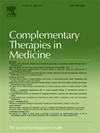不同频率的经皮穴位电刺激对轻度高血压的影响:随机对照试验。
IF 3.5
3区 医学
Q1 INTEGRATIVE & COMPLEMENTARY MEDICINE
引用次数: 0
摘要
背景:经皮穴位电刺激(TEAS)可能有助于控制血压(BP),但证据仍然不足。我们的目标是评估经皮穴位刺激疗法对高血压的影响,并确定最佳频率:共有 120 名高血压患者按 1:1:1 的比例随机分配到 TEAS-2Hz 组、TEAS-10Hz 组或常规护理对照组。所有患者均被建议继续其常规的降压治疗方案。此外,TEAS组患者每周接受3次TEAS治疗,为期4周,随访4周:主要结果是收缩压(SBP)从基线到第4周的变化。次要结果包括不同时间点的舒张压(DBP)、平均动脉压(MAP)、心率(HR)、心率变异性(HRV)和 12 项健康调查(SF-12)的变化。与对照组相比,TEAS 两组的 SBP 均有所降低(TEAS-2Hz 组与对照组相比,-4.70mmHg [95% CI,-7.00 至 -2.40mmHg];P <0.001;TEAS-10Hz 组与对照组相比,-8.66mmHg [95% CI,-10.97 至 -6.36mmHg];P <0.001)。与 TEAS-2Hz 相比,TEAS-10Hz 可显著降低 SBP(-3.96mmHg [95% CI, -1.66 to -6.26mmHg];P < 0.001)。与对照组相比,TEAS 组的 DBP、MAP、HR、LF/HF 比值(LF/HF)、极低频(VLF)和正常化低频(LF 正常值)也有所降低,而正常化高频(HF 正常值)则有所升高。各组在低频(LF)、高频(HF)、总功率(TP)、极低频(VLF)和 SF-12 方面均无差异:TEAS可能是一种很有前景的高血压辅助疗法,建议频率为10Hz,这一点应在更大规模的试验中得到证实。本文章由计算机程序翻译,如有差异,请以英文原文为准。
Effect of transcutaneous electrical acupoint stimulation at different frequencies on mild hypertension: A randomized controlled trial
Background
Transcutaneous electrical acupoint stimulation (TEAS) may contribute to blood pressure (BP) control, but the evidence remains insufficient. Our objectives were to evaluate the impact of TEAS on hypertension and determine the optimal frequency.
Methods
A total of 120 hypertensive patients were randomly allocated to the TEAS-2Hz group, TEAS-10Hz group, or usual care control group in a 1:1:1 ratio. All patients were advised to continue their usual antihypertensive regimen. Additionally, patients in the TEAS groups received TEAS therapy 3 times per week for 4 weeks, with a 4-week follow-up.
Results
The primary outcome was the change in systolic BP (SBP) from baseline to week 4. Secondary outcomes included changes in diastolic BP (DBP), mean arterial pressure (MAP), heart rate (HR), heart rate variability (HRV), and 12-item health survey (SF-12) at different time points. Both TEAS groups showed reductions in SBP relative to control (TEAS-2Hz group vs. control, −4.70 mmHg [95 % CI, −7.00 to −2.40 mmHg]; P < 0.001; TEAS-10Hz group vs. control, −8.66 mmHg [95 % CI, −10.97 to −6.36 mmHg]; P < 0.001). TEAS-10Hz provided a significant decrease in SBP than TEAS-2Hz (-3.96 mmHg [95 % CI, −1.66 to −6.26 mmHg]; P< 0.001). TEAS groups also exhibited reductions in DBP, MAP, HR, LF/HF ratio(LF/HF), very low frequency (VLF), and normalized low frequency (LF norm), and an increase in normalized high frequency (HF norm) than control. No differences were observed among groups in low frequency (LF), high frequency (HF), total power (TP), very low frequency (VLF), and SF-12.
Conclusion
TEAS might be a promising adjunctive therapy for hypertension, and the recommended frequency is 10 Hz, which should be confirmed in larger trials.
求助全文
通过发布文献求助,成功后即可免费获取论文全文。
去求助
来源期刊

Complementary therapies in medicine
医学-全科医学与补充医学
CiteScore
8.60
自引率
2.80%
发文量
101
审稿时长
112 days
期刊介绍:
Complementary Therapies in Medicine is an international, peer-reviewed journal that has considerable appeal to anyone who seeks objective and critical information on complementary therapies or who wishes to deepen their understanding of these approaches. It will be of particular interest to healthcare practitioners including family practitioners, complementary therapists, nurses, and physiotherapists; to academics including social scientists and CAM researchers; to healthcare managers; and to patients. Complementary Therapies in Medicine aims to publish valid, relevant and rigorous research and serious discussion articles with the main purpose of improving healthcare.
 求助内容:
求助内容: 应助结果提醒方式:
应助结果提醒方式:


